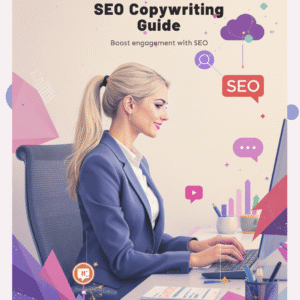Have you ever been so captivated by a piece of writing that it sparked a desire deep within you?
A burning curiosity to learn more and take action to be part of something bigger?
I know I have.
As an aspiring copywriter, I’ve experienced the immense power of persuasive language firsthand.
Whether you’re dreaming of a career as a freelance copywriter or want to improve the copy for your business, this guide will equip you with the essential skills to make an impact.
Throughout this copywriting tutorial for beginners guide, you’ll discover the art of persuasive writing, uncover the elements of great copy, and gain practical tips to elevate your skills.
What is Copywriting and Why is it Important?
Copywriting is a powerful tool that drives business growth by crafting compelling content that motivates readers to take action.
With the ability to convey meaningful messages, tell captivating stories, and forge connections with potential customers, copywriting is an indispensable skill for business success.
Copywriting uses persuasive language and storytelling techniques to create content that resonates with the audience’s emotions and motivations.
Whether it’s crafting attention-grabbing headlines, capturing the essence of a brand in a tagline, or creating engaging website copy, every word is strategically chosen to compel readers to engage and convert.
Why is Copywriting Important for Business Growth?
Understanding the fundamentals of copywriting and harnessing its power can unlock tremendous potential for driving business growth.
By effectively communicating your brand’s message, compelling readers to take action, and building meaningful connections with your target audience, copywriting becomes a catalyst for success in today’s competitive business landscape.
9 Elements of Great Copywriting
Great copywriting possesses essential elements that elevate average copy to the next level. These elements are crucial in creating persuasive content that captures readers’ attention and drives them to take the desired action.
1. Grammatically Sound
Grammatically sound copy is the foundation of effective communication.
It ensures clarity, credibility, and professionalism.
By writing copy that follows proper grammar rules and avoids spelling mistakes, you can establish trust with your audience and avoid negative perceptions of your brand.
2. Persuasive
Effective copywriting is persuasive, arousing emotions and convincing readers to take action.
By understanding the needs and desires of your target audience, you can create compelling copy that resonates with them on a deeper level.
Use persuasive language, storytelling techniques, and strong arguments to engage your readers in decision-making.
3. Jargon-Free
Be sure to avoid jargon and technical language that may confuse or alienate your audience to ensure clarity and accessibility.
Use simple language everyone can understand, making your copy relatable and easy to digest.
4. Strong Call to Action (CTA)
A strong call to action guides readers toward the desired action.
Whether it is for making a purchase, signing up for a newsletter, or downloading a resource, your CTA should be clear, compelling, and easy to follow.
Make it stand out visually and use persuasive language to encourage immediate action.
5. SEO-Friendly
Writing copy optimized for search engines (SEO) can greatly enhance your online visibility.
Incorporate relevant keywords, and meta descriptions, and properly structure your content to improve your search engine rankings.
When your copy ranks higher in search results, it becomes more accessible to your target audience.
6. Direct
Direct copy is concise and to the point.
Avoid being verbose or using unnecessary fluff that can dilute your message.
By getting straight to the point, you respect your readers’ time and increase the chances of capturing their attention and keeping them engaged.
7. Captivating Lead
A captivating lead is crucial for grabbing readers’ attention from the very beginning.
Start your copy with a powerful hook, an interesting fact, or a thought-provoking question that immediately sparks curiosity.
You create a strong foundation for the rest of your copy by captivating your audience from the start.
8. Channel-Specific
Adapting your copy to different channels and mediums is key to maximizing its effectiveness.
Consider the unique characteristics of each platform and tailor your copy to suit the specific distribution method.
Whether it’s a social media post, email newsletter, or landing page, make sure your copy aligns with the strengths and limitations of each channel.
9. Audience Awareness
Understanding your target audience is vital for creating copy that resonates with them.
Take the time to research and analyze your audience’s needs, preferences, and pain points.
By demonstrating a deep understanding of their desires and motivations, you can create copy that truly speaks to them and compels them to take action.
Tips for Beginner Copywriters

As a beginner in copywriting, I understand the challenges of mastering this art form.
With dedication and the right techniques, you can become a skilled copywriter.
Here are some essential tips to help you get started and create an effective copy:
Know your audience: Understand who you are targeting before writing any copy. Research your audience’s demographics, interests, and pain points to create tailored and persuasive content.
Keep your writing simple: Use clear and concise language that is easy to understand. Avoid jargon and unnecessary complexity, focusing on delivering your message effectively.
Focus on the “why”: Instead of simply describing features, emphasize the benefits of your product or service. Explain why your audience needs what you’re offering and how it can improve their lives.
Speak directly to your reader: Use a conversational tone to establish a connection with your audience. Address them directly, creating a sense of personal interaction.
Take readers on a journey: Craft your copy to tell a story that captivates and engages your audience. Paint a vivid picture of their problem and how your solution will guide them towards a resolution.
Use strong headlines: Grab your reader’s attention with compelling and attention-grabbing headlines. A powerful headline sets the tone for the rest of your copy and entices your audience to keep reading.
Focus on benefits rather than features: Highlight the value of your product or service. Instead of listing its features, explain how it solves a problem or fulfills a desire.
Understand copywriting formulas: Familiarize yourself with formulas like AIDA (Attention, Interest, Desire, Action) and PAS (Problem, Agitate, Solution). These frameworks can guide you in structuring persuasive copy.
Outline and edit your work: Before writing, create an outline to organize your thoughts and ensure a logical flow. Afterward, edit your work for clarity, conciseness, and grammar mistakes.
Leverage social proof: Incorporate testimonials, reviews, case studies, and social media shares to build trust and credibility. Social proof validates your claims and helps overcome skepticism.
Include a clear call to action (CTA): Direct your audience towards the desired action by including a clear and compelling CTA. Make it easy for them to take the next step.
Track analytics: Utilize tracking tools to measure the performance of your copy. Monitor metrics such as click-through rates, conversion rates, and engagement levels to optimize your future campaigns.
Stay true to yourself: Develop your unique writing style and voice. Authenticity resonates with readers and sets you apart from competitors.
By following these copywriting tips for beginners, you’ll be well on your way to creating a persuasive and impactful copy.
Remember to practice, adapt, and continuously learn as you develop your skills in this exciting field.
Learning Copywriting for Beginners

Learning copywriting as a beginner can seem daunting, but it is a skill that can be acquired with dedication and practice.
Understanding the basics through reading books and online resources, taking online courses, and practicing regularly are essential steps.
Reading Books: One great way to learn copywriting is by exploring books written by experts in the field.
These books provide valuable insights, techniques, and examples that help beginners grasp the fundamentals of effective copywriting.
Some recommended books for beginners include:
- “The Copywriter’s Handbook” by Robert Bly
- “Hey, Whipple, Squeeze This: A Guide to Creating Great Ads” by Luke Sullivan
- “Ca$hvertising” by Drew Eric Whitman
Online Resources: The Internet offers a wealth of information on copywriting, making it accessible to anyone with an Internet connection.
Various websites, blogs, and online communities provide introductory copywriting lessons, tips, and examples to help beginners improve their copywriting skills.
Websites such as Copyblogger and HubSpot offer valuable resources for beginners.
Online Courses: Taking online courses specifically designed for beginners is another effective way to learn copywriting.
These courses provide structured lessons, assignments, and feedback from industry professionals.
Platforms like Udemy and Skillshare offer a wide range of copywriting courses suitable for novices.
Practicing Regularly: Practice is essential for developing any skill, and copywriting is no exception.
Beginners should make a habit of practicing copywriting regularly, whether it’s writing mock advertisements, creating social media posts, or drafting website copy.
Through consistent practice, beginners can refine their skills and gain confidence in their abilities.
Copywriting Examples
Analyzing successful copywriting examples and joining online communities can further enhance the learning experience.
By studying and deconstructing persuasive copy, beginners can gain insights into what makes effective copywriting.
Engaging with online communities of copywriters allows beginners to seek guidance, share ideas, and receive feedback from like-minded individuals.
Seek Feedback
Seeking feedback from peers, mentors, or professional copywriters is invaluable for the growth of copywriting skills.
Constructive feedback provides valuable insights and suggestions for improvement.
Staying updated with copywriting tips, trends, and industry best practices through blogs, podcasts, and newsletters is crucial for staying ahead of the curve and honing your craft.
3 Examples of Persuasive Copywriting
Studying and analyzing persuasive copywriting examples can be a valuable exercise for beginner copywriters.
By examining successful advertisements and marketing campaigns, we can gain insights into what makes copy effective and how to apply these principles to our writing.
The few examples below demonstrate the power of persuasive language and its impact on readers.
1. Strong Headlines
A compelling headline is crucial for grabbing attention and enticing readers to engage with the content.
For example, take the renowned Nike campaign: “Just Do It.”
This simple yet powerful phrase encapsulates the brand’s spirit of determination and ambition, motivating individuals to push beyond their limits.
2. Compelling Calls to Action (CTAs)
Effective copy includes clear and compelling calls to action that prompt readers to take a specific desired action.
A great example is the CTA used by Dropbox: “Get started for free.”
This concise and enticing phrase encourages users to sign up and experience the benefits of the service, leading to increased conversions.
3. Storytelling Techniques
Storytelling is a powerful tool in copywriting that captures attention and builds an emotional connection.
The “Share a Coke” campaign by Coca-Cola is a prime example.
People felt a sense of inclusion and shared experiences, prompting them to share their own Coke stories on social media by personalizing their bottles with popular names
“Studying and analyzing persuasive copywriting examples can deepen understanding and provide inspiration for creating effective copy.”
Learning from Effective Copy
Through the above examples, we can see how persuasive copy captivates an audience and drives action.
Beginner copywriters can hone their writing skills and create compelling content by understanding the elements that make these examples effective.
- Develop attention-grabbing headlines that spark curiosity and generate interest.
- Create compelling calls to action (CTAs) that communicate the desired action and entice readers to take it.
- Utilize storytelling techniques to tap into emotions and create a personal connection with the audience.
Remember, effective copywriting is a combination of art and science.
By studying and analyzing persuasive copywriting examples, you can gain valuable insights and inspiration for creating impactful content.
Recommended Resources for Learning Copywriting

Whether you prefer to dive into a good book or immerse yourself in an online course, there are options available to suit your learning style and schedule.
Here are some recommended resources for beginners looking to enhance their copywriting skills:
| Book Title | Author |
|---|---|
| The Copywriting Secret | Jim Edward |
| The Adweek Copywriting Handbook | Joseph Sugarman |
These books offer valuable insights, techniques, and tips from experienced copywriters.
They cover everything from crafting persuasive headlines to creating compelling calls to action.
By studying the strategies outlined in these books, you can develop a solid foundation in copywriting.
In addition to books, online courses provide accessible and comprehensive learning opportunities.
Platforms like Udemy offer free courses taught by industry professionals.
YouTube is also a great resource, with experienced copywriters like Alex Cattoni and Dan Lok sharing tutorials and tips.
Final Thoughts
Copywriting is a skill that can be learned and perfected with dedication and practice.
It is an essential tool for businesses and individuals looking to convey their message effectively and persuade their audience to take action.
By following the tips and resources provided in this guide, beginners can develop their copywriting skills and create compelling content.
Remember that copywriting is a journey, and improvement comes with practice and continued learning.
Embrace the process, seek feedback, and stay updated with copywriting tips and trends.
By persistently honing your skills, you can become a proficient copywriter and enjoy the rewards that come with it.



